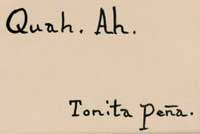Original Painting of a San Ildefonso Pueblo Eagle Dance by Tonita Peña [SOLD]
+ Add to my watchlist Forward to Friend
- Category: Paintings
- Origin: San Ildefonso Pueblo, Po-woh-ge-oweenge
- Medium: gouache
- Size:
9" x 12-1/2" image;
18-¼ x 21-1/8” framed - Item # C4139B SOLD
This untitled San Ildefonso Pueblo painting by "the dean of Indian women painters" will most likely appeal to collectors of unique early pueblo watercolors. Here, Tonita Peña painted two Eagle Dancers. Behind them, a drummer and another dancer follow. The two Eagle Dancers are nearly identical, with slight variations in color and form. The artist chose atypical colors for their skin and kilts, using a strong mustard yellow and a beautiful pale orange, respectively. Most notably unique is the linework—here, it is less detailed than the artist's norm. This observation might sound like a slight, but it is most certainly not intended as such. While her meticulously crafted works are undoubtedly impressive, this painting's unconstrained feel absolutely works in its favor. Dunn's description of Peña's work highlighted the artist's authenticity and lack of pretension. This painting, with its looser-than-usual composition and unusual color choices, exemplifies those qualities.
Tonita Peña, whose Tewa name was Quah Ah, was born in 1893 in the tiny New Mexico pueblo of San Ildefonso. The pueblo is located on the Rio Grande, just north of Santa Fe. At the age of 12, her mother passed away and her father, unable to raise her and tend his fields and pueblo responsibilities, took her to live with her aunt and uncle at Cochiti Pueblo. This was where she would spend the remainder of her life. She was the only woman in the group of talented early pueblo artists referred to as the San Ildefonso Self-Taught Group, which included such noted artists as Julian Martinez, Alfonso Roybal, Abel Sanchez, Crecencio Martinez, and Encarnación Peña. Pena became a successful, influential, and highly regarded painter. She passed away in 1949, leaving behind a large body of work.
Dorothy Dunn stated that “Quah Ah’s art is an art of radiance and tranquility. It is possessed of delicacy and grace, and much music. It is unequalled at conveying the dignity, the serenity, the great earnestness and wholehearted sincerity of the Pueblo ceremonial and the Pueblo people. Quah Ah’s work is not ever spectacular or striking, but it is completely unpretentious and authentic. She might be called a conservative painter for she has set her own standards in keeping with tradition and has adhered to them through the years so consistently that, even beyond her death, she has never been superseded as the dean of Indian women painters."
 Peña’s signature evolved over the course of her career. The signature used in this piece—”Quah Ah” above “Tonita Peña”—suggests that this piece was completed in the 1920s. Prior to this period, she signed only her Tewa name. After this period, she began elaborating on her signatures with various decorative motifs.
Peña’s signature evolved over the course of her career. The signature used in this piece—”Quah Ah” above “Tonita Peña”—suggests that this piece was completed in the 1920s. Prior to this period, she signed only her Tewa name. After this period, she began elaborating on her signatures with various decorative motifs.
Condition: this Original Painting of a Pueblo Eagle Dance by Tonita Peña is in excellent condition
Provenance: from a the private collection of Washington resident
Suggested Reading: American Indian Painting of the Southwest and Plains Areas by Dorothy Dunn
Note the Tewa Pueblos: San Ildefonso, Tesuque, San Juan, Santa Clara, Nambe, Pojoaque
Tonita Peña - Image Source: from the book Tonita Peña by Samuel L. Gray. Photo by T. Harmon Parkhurst. Museum of New Mexico Fine Arts Collection, negative #46988.
Relative Links: Tonita Peña, San Ildefonso, Cochiti Pueblo, Julian Martinez, Alfonso Roybal, Abel Sanchez, Crecencio Martinez, Encarnación Peña, painting
- Category: Paintings
- Origin: San Ildefonso Pueblo, Po-woh-ge-oweenge
- Medium: gouache
- Size:
9" x 12-1/2" image;
18-¼ x 21-1/8” framed - Item # C4139B SOLD



